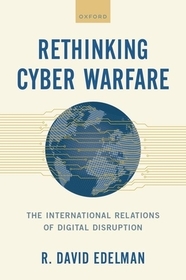
Rethinking Cyber Warfare
The International Relations of Digital Disruption
- Publisher's listprice GBP 32.99
-
15 760 Ft (15 010 Ft + 5% VAT)
The price is estimated because at the time of ordering we do not know what conversion rates will apply to HUF / product currency when the book arrives. In case HUF is weaker, the price increases slightly, in case HUF is stronger, the price goes lower slightly.
- Discount 10% (cc. 1 576 Ft off)
- Discounted price 14 184 Ft (13 509 Ft + 5% VAT)
Subcribe now and take benefit of a favourable price.
Subscribe
15 760 Ft

Availability
Estimated delivery time: Expected time of arrival: end of January 2026.
Not in stock at Prospero.
Why don't you give exact delivery time?
Delivery time is estimated on our previous experiences. We give estimations only, because we order from outside Hungary, and the delivery time mainly depends on how quickly the publisher supplies the book. Faster or slower deliveries both happen, but we do our best to supply as quickly as possible.
Product details:
- Publisher OUP USA
- Date of Publication 29 August 2024
- ISBN 9780197509685
- Binding Hardback
- No. of pages416 pages
- Size 236x163x26 mm
- Weight 748 g
- Language English 991
Categories
Short description:
Rethinking Cyber Warfare provides a fresh understanding of the role that digital disruption plays in contemporary international security and proposes a new approach to more effectively restrain and manage cyberattacks.
MoreLong description:
Fifteen years into the era of “cyber warfare,” are we any closer to understanding the role a major cyberattack would play in international relations - or to preventing one? Uniquely spanning disciplines and enriched by the insights of a leading practitioner, Rethinking Cyber Warfare provides a fresh understanding of the role that digital disruption plays in contemporary international security.
Focusing on the critical phenomenon of major cyberattacks against wired societies, the book reconsiders central tenets that shaped global powers' policies and explains what forces in the international system might durably restrain their use. Arming the reader with the key technological and historical context to make sense of cyberattacks, it explores how deterrence, international law, and normative taboos operate today to shape whether and how states think about causing this kind of disruption - and how soon those forces might combine to rethink those decisions entirely.
The result is a comprehensive look at one of the most pressing issues in international security that also illuminates a new pathway for managing one of its greatest sources of instability.
At 340 pages of elegantly written but dense text, and with an extraordinarily rich 36-page bibliography, the book was written for academics and, perhaps to a lesser extent, serious policy makers....the book will be an important addition to the curriculum in military academies and university level courses on regulating cyberspace. Moreover, it will be exceptionally useful for those in the world of statecraft and the military who want to think more deeply about how the international order can and should bring some level of control to cyberweapons.
Table of Contents:
Introduction
Part I Cyberattacks and Restraint
Defining and Studying Cyberattacks
Defining and Studying Restraint
Part II Deterrence
Evaluating Deterrence
Constructing Deterrence
Part III International Law and the Use of Force
Limiting the Use of Force
Constructing Self-Defense
Part IV Humanitarian Protections
Humanitarian Protections
Constructing a Prohibition
Conclusion




